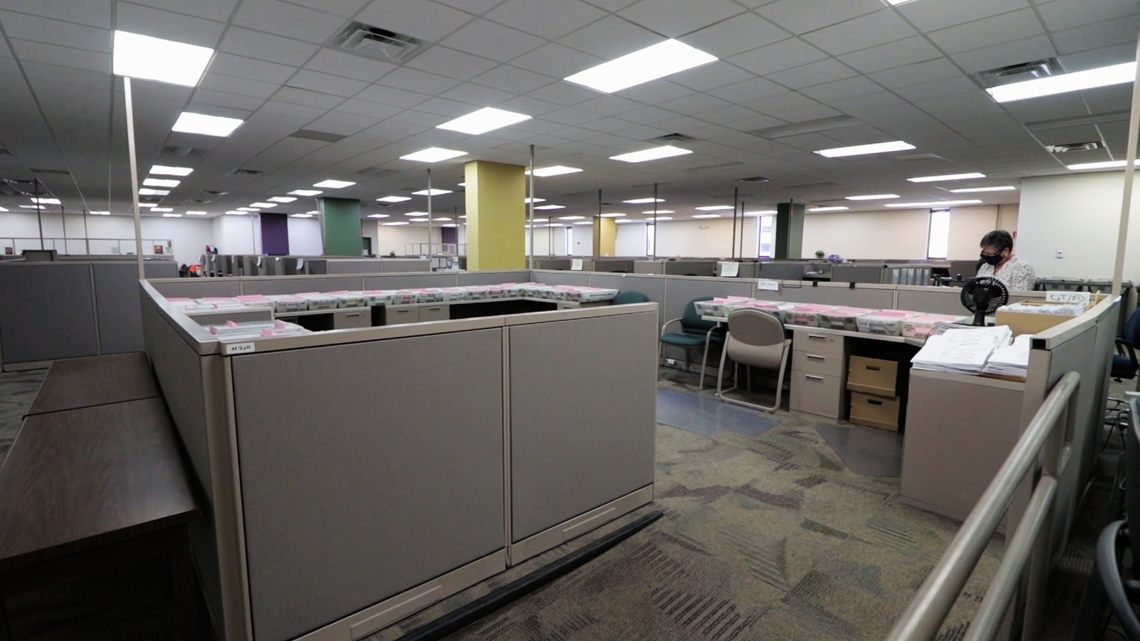AUSTIN, Texas — You can count more than two dozen bins full of returned mail at the Texas Workforce Commission (TWC) telecommunications office in Fort Worth.
Stacks of envelopes sent back from employers show who never got a notice a past employee claimed unemployment. The business address was no good.
“Right now with the pandemic, the amount of paperwork that we're dealing with is historic. Normally, we would come back with a bin of mail from the post office, and we've come back with two carloads,” said Beth Dismuke, TWC operations coordinator with the North Texas TWC Telecenter.
The telecenter is one of four call centers owned and operated by the TWC. It’s one of eight handling pandemic unemployment claims.
“It was my full-time job to call TWC,” said Troy Jordan in June 2020.
Jordan said he tried for months to get through to the State with issues about his unemployment claim.
We asked TWC to show us what’s happening on their end of the phone line.
“Our average number of calls per day is 13,000. When the pandemic hit, we had three million calls trying to come through in a day,” Dismuke said.


The agency started hiring hundreds of people to take calls.
With hiring, Dismuke said, comes training. New employees must learn how to take the information and work through problems. Then, quickly learn how to navigate through several different programs other than Unemployment Insurance (UI).
Claimants may qualify for a range of programs including Extended Benefits (EB), Pandemic Emergency Unemployment Compensation (PEUC), Disaster Unemployment Assistance (DUA), Pandemic Unemployment Assistance (PUA), Lost Wages Assistance (LWA), Unemployment Compensation for Federal Employees (UCFE), Unemployment Compensation for Ex-Servicemembers (UCX), Trade Readjustment Allowances (TRA) and Shared Work.
“Normally, it might take two years for you to get through all the skills, and we're doing it in six months,” Dismuke said.
All employees needed training on pandemic-related programs, such as PEUC. And social distancing forced folks to work from home in the middle of hiring.
“We need to learn how to do remote teaching,” Dismuke said.
Personal information needed to be kept safe outside the cubicles and calls to TWC phones needed to be routed to an employee’s home. An entire remote infrastructure needed to be built.
“It’s a very complicated program, but really seeing great improvement,” said Clay Cole, director of the Unemployment Insurance Division at a TWC commission meeting on Sept. 22.
Cole told commissioners the agency still has a backlog of people needing help.
“Over the last approximately 30 days, we were able to see a net reduction of over 140,000 assignments,” said Cole.
“When you call in, what we want to do is one call resolution,” Dismuke said.
When the pandemic hit and unemployment surged, most callers needed to file for unemployment. Now, Dismuke said, most have claim issues – those calls can take longer.
“These claims are complicated. They take time. So we don't want to rush one person off the phone so that we can get another person on the phone,” Dismuke said.
TWC has a surge in appeals stemming from the high unemployment claims. The average wait for a response hearing is 45 to 70 days.
If you need to call the TWC telecenter (800-939-6631), Dismuke suggests to call early in the morning or on the weekend.
PEOPLE ARE ALSO READING:

